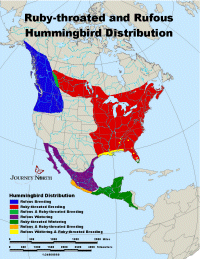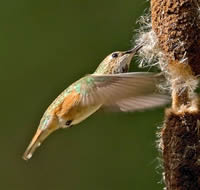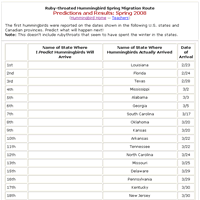Today's Report Includes:
- The
Migration: Highlights,
Maps, and
Questions
-
Journal:
Imagine
Building the Perfect Nest
- Looking
at Data: The
Long Journey (So Far)
Your Sightings! >>
 Distribution Map |
||
| Rufous
|
Ruby-throated
|
|
| Handouts:
Today's Hummingbird Map Questions Rufous Questions > Rubythroat Questions > |
||
|
Highlights:
Buzzing, Slowing, Buzzing Again! |
Some hummingbirds are still traveling north, but others have arrived in places where they'll breed. Once they've mated, the females will busily begin building nests.
How do they prepare for this important stage of their annual cycles? Imagine you are a hummer. Make a list of what you might need for a safe and secure nest. How would you go about building one? This photo gives you one clue!
- Respond in your Hummingbird Journal! >>
- Then come back for next week's slideshow.
Have you kept track of rubythroat first arrivals in each state? We have. It's time to start digging into the data! As you look at your own chart, or Journey North's Predictions and Results chart, see what you can learn:
- Show
the Data: Use
a blank
map to show some data from the chart. For instance, you
could decide to color in the states that had first hummer arrivals in
February with one color, March with another color, and so on.
- Analyze the Data: What does your map tell you about the hummingbird migration? Pick one thing and write a couple of sentences. What questions does it raise?
- Video Clip: A Hummingbird Tongue in Action! >> (May take a few minutes to load.)
- Photo Observation: A Body Part That "Fits"! What Clues Do You See? >>
- Slideshow: Make Way for Nesting: A Tale of Territories, Thieves, and Courtship >>
- Lesson: Short-Distance and Long-Distance Migrants: Comparing Robins and Hummingbirds >>
- Questions: Expert Answers to Your Hummingbird Questions >>
- Study: Weather and Songbird Migration >>
- Hummingbird Migration Journals (click-and-print) >>
The Next Hummingbird Migration Update Will Be Posted on April 24, 2008.







